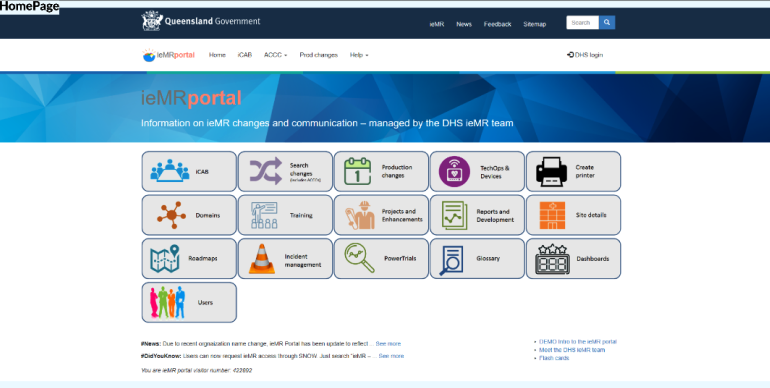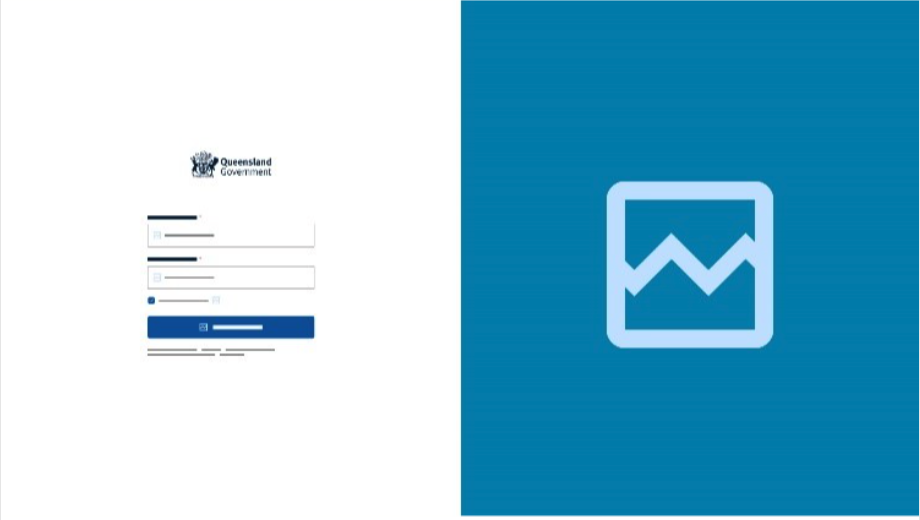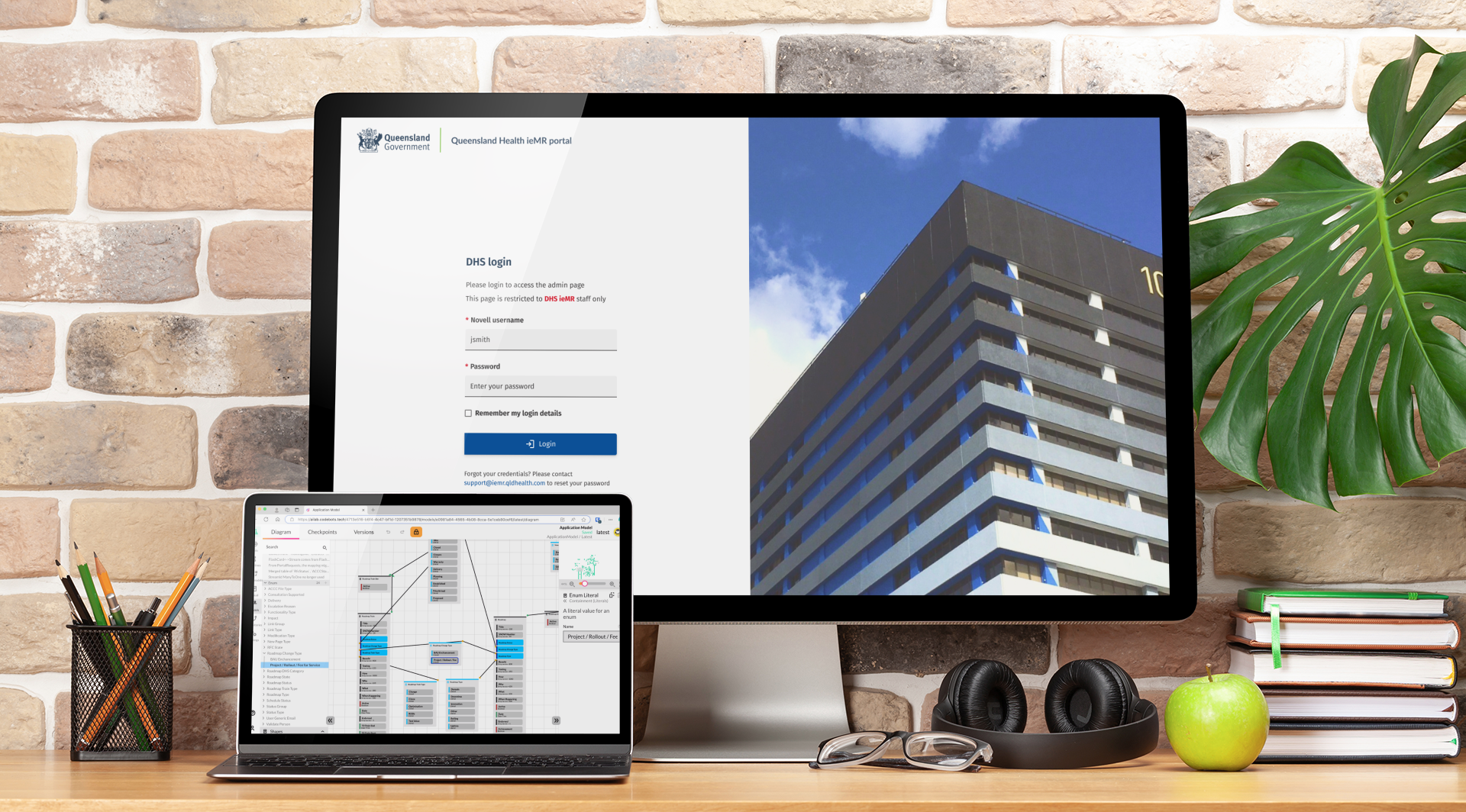Case Study: Queensland Health ieMR Configuration Portal Modernisation
Circumstance
Queensland Health’s ieMRPortal Configuration Portal is a vital platform for managing the ieMR rollout plan. The system suffered from performance issues, security vulnerabilities, and an inability to scale, leaving the ieMR team frustrated and constrained in their capacity to maintain the portal due to its overbearing technical debt.
To address these challenges, Queensland Health, Digital Health Solutions (DHS) partnered with WorkingMouse to modernise the system. The
objectives were clear: improve performance, enhance user workflows, ensure scalability, and establish a foundation for future system
integration.
Action
The modernisation effort began with a four-week discovery phase. During this period, WorkingMouse had frequent huddles with Queensland Health to identify pain points, clarify goals, and establish a roadmap for the project. The WorkingMouse team led user interviews, translated Queensland Health’s public-facing design system into a model, and identified inefficiencies in the existing workflows.
The technical approach to the project was supported by a comprehensive modelling process, which used WorkingMouse’s proprietary methodologies and Codebots’ 4th Generation platform.
A suite of models, integrated into WorkingMouse’s low-code platform engineering system, made sure that every aspect of the application was carefully planned and executed:
-
App Flow Model: Captured the screens and core user flows of the legacy application to ensure no functionality was overlooked.
- Application Model: Defined the target database schema as part of the database migration process.
- Application Query Model: Mapped GraphQL queries, linking the C# bot Entity and UI Models.
- C# bot Entity Model: Designed the database schema and core features of the application.
- C# bot Security Model: Established baseline data security protocols.
- C# bot UI Model: Modelled the backend user interface components.
- UI Model: Designed the frontend user interface to ensure an intuitive and accessible user experience.
- Database Migration Model: Mapped the transformation from the legacy database schema to the modernised schema.
- Legacy Database Model: Documented the structure of the existing database.
- Requirements Model: Organised the backlog and project requirements, ensuring alignment with project goals.
- Prince2 Model: Applied a Prince2 Project Management framework to track progress and milestones effectively.

Screenshot of the Codebots UI model

Screenshot of the Codebot Application Model
An important aspect of the project was transitioning to a new technology stack, including .NET 6, React, Chakra UI, and TypeScript. This move allowed for modern development practices, and a more scalable, modular, and efficient architecture, with the capacity to scale with future needs.
Database migration posed significant challenges. The WorkingMouse team designed a custom tool to transform data from the old database model into the new application schema, improving data integrity and minimising downtime. Unlike conventional methods, which often involve directly copying data between systems, this approach made sure that the integrity of complex data structures was maintained.
To replicate the extensive functionality of the legacy system, the team used Codebots to automate the reproduction of pages and features through the User Interface (UI) model. This allowed the developers to focus on optimising workflows and enhancing user experience rather than manually rebuilding every component.
 Landing
page before and after
Landing
page before and after

 Final
design (left) and the prototype (right)
Final
design (left) and the prototype (right)

The UI model was built to eHealth’s new design system. This means the Jidoka Breadth first approach could be taken to gain significant
coverage, empowering elements to be further customised later.
The eHealth design team called it “The best ‘external’ implementation of their design system they had ever seen!”
Result
The modernised ieMRPortal was faster, more reliable, and easier for the DHS team to operate. The microservice architecture provided a scalable solution, ready to adapt to future integrations and increased user demands.
The user interface, developed using Chakra UI and React, was designed to be clean, modern, and intuitive, significantly enhancing the overall user experience. Beyond user experience improvements, the enhanced system also streamlined internal development processes and improved productivity for Queensland Health’s IT team.
By leveraging Codebots’ Generation 4 workflow and comprehensive modelling, the project achieved high levels of precision and efficiency. The ability to model everything from database schemas to user interfaces and project management workflows allowed the team to maintain alignment with the project’s goals while minimising risks.
This improvement, which was driven by the Jidoka process, enabled WorkingMouse to build most of the application and cover all core features within the short time frame. After this, the final customisations were done by the internal DHS team, this allowed them to focus on more strategic initiatives.
Ethical Behaviour
Throughout the project, WorkingMouse upheld ethical standards. Open communication with Queensland Health and a transparent approach to decision-making ensured trust and accountability at every stage. Regular feedback loops and user involvement ensured the solution met the real-world needs of its end-users.
Although the application was not public-facing, data security remained a priority. The migration process adhered to compliance standards, ensuring all internal data was handled securely and confidentially.
Sustainability
The modernised ieMRPortal was designed with long-term sustainability in mind. Its architecture allows Queensland Health to scale the platform to meet future demands, integrate additional systems, and adopt emerging technologies.
Reusable models, developed during the project, provide significant value for Queensland Health’s broader digital transformation efforts. These models reduce resource consumption and development time for future projects.
The new system’s improved workflows and architecture align with Queensland Health’s vision of delivering efficient, reliable, and modern healthcare services. By addressing inefficiencies and preparing for scalability, the ieMRPortal modernisation represents a future-proof investment in healthcare technology.
Conclusion
The Queensland Health ieMRPortal modernisation shows how innovative methodologies and collaborative approaches can transform outdated systems into scalable, efficient platforms. By using advanced modelling techniques and innovative technology, WorkingMouse delivered a solution that not only met the client’s needs but also positioned Queensland Health for long-term success.





